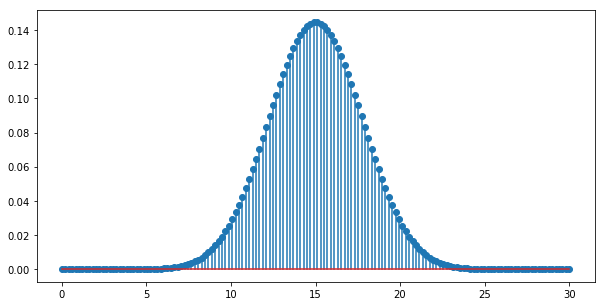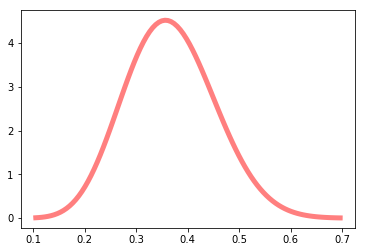Ref: https://www.countbayesie.com/blog/2015/3/17/interrogating-probability-distributions
Equation to obtain the discrete probability (dp) of having n values in k attempts
import math
import scipy
import matplotlib.pyplot as plt
import numpy as np
from matplotlib import colors
from scipy import integrate
from scipy.stats import betadef scipyFactorial(k, n):
return scipy.special.binom(k, n)
def probabilityMassFunction(n, k, p):
heads = scipyFactorial(k,n)
tails = math.pow(p, n) * math.pow(1-p, k-n)
return heads * tails
n=10
k=30
p=0.5
print("Probability of having {} tails is {:0.3f}".format(n, probabilityMassFunction(n,k,p)))
# x = [i for i in range(k)]
x = np.linspace(0, k, 30*5)
y = [probabilityMassFunction(i,k,p) for i in x]
plt.figure(figsize=(10,5))
plt.stem(x, y, use_line_collection=True)
plt.show()Probability of having 10 tails is 0.028
first = 18
last = 25
def probabilityMassFunctionRange(first, last, k, p):
values = [x for x in range(first,last, 1)]
total = 0
for i in values:
total += probabilityMassFunction(i,k,p)
return total
print("Probability of having between {} and {} tails (inclusive) is {:0.3f}".format(first, last, probabilityMassFunctionRange(first, last, k, p)))Probability of having between 18 and 25 tails (inclusive) is 0.181
a, b = 11, 19
mean, var, skew, kurt = beta.stats(a, b, moments='mvsk')
print("mean: {}, variance: {}, skew: {}, kurt: {}".format(mean, var, skew, kurt))
x = np.linspace(beta.ppf(0.0001, a, b),
beta.ppf(0.9999, a, b), 100)
plt.plot(x, beta.pdf(x, a, b),
'r-', lw=5, alpha=0.5, label='beta pdf')mean: 0.36666666666666664, variance: 0.007491039426523298, skew: 0.19256515705838026, kurt: -0.12788168769030014
[<matplotlib.lines.Line2D at 0x10eaa0630>]
minimum = 0.2
maximum = 0.5
ii = integrate.quad(beta.pdf, minimum, maximum, args=((a, b)))
print("What is the probability that p is between {} and {}?: {:0.3f}".format(minimum, maximum, ii[0]))What is the probability that p is between 0.2 and 0.5?: 0.912
Reference: https://www.countbayesie.com/blog/2019/6/12/logistic-regression-from-bayes-theorem
Calculate the odds between two hypothesis
O(H|D) =
But this is not good to fit into a linear equation:
y =
For this, we can use the Log function
What we need is really just that:
Or that
To make it fit with what we need:
but because 1/0 is undefined, and ln(0) is also undefined, we need to modify the equation to handle these values on the right side
Where
-
$\beta D$ is$ln(\frac{P(D|H)}{P(D|\bar{H})})$ -
Our prior odds,
$\beta_0$ is$ln(O(H))$ , or$ln(\frac{P(H)}{P(\bar{H})})$
\frac{P(H|D)}{P(\bar{H}|D)} = \frac{P(D|H)P(H)}{P(D|\bar{H})P(\bar{H})}
ph = 3
pnh = 1
d = 30
h = 1
b0, var, skew, kurt = beta.stats(ph, pnh, moments='mvsk')
print("b0 (prior that the coffee will be good): {}".format(b0)) # b0 = ln(p(h)/p(!h))
bD, var, skew, kurt = beta.stats(d, h, moments='mvsk')
print("bD (probability of the data given the hypothesis): {}".format(bD))
lo = math.exp(bD) + math.exp(b0)
print("lo(H|D) = bD + b0 = {}".format(bD, b0, lo))
print("Probability of the Hypothesis given the data")
print("P(H|D) = {}".format((1/(1+math.exp(-(lo))))))b0 (prior that the coffee will be good): 0.75
bD (probability of the data given the hypothesis): 0.967741935483871
lo(H|D) = bD + b0 = 0.967741935483871
Probability of the Hypothesis given the data
P(H|D) = 0.9914139600794254

